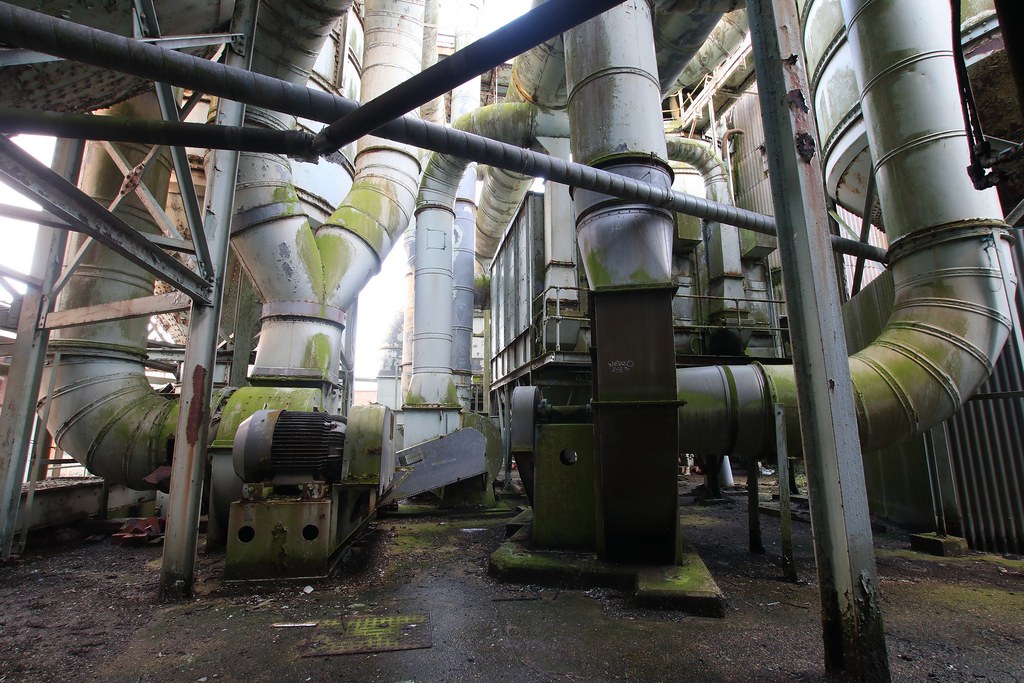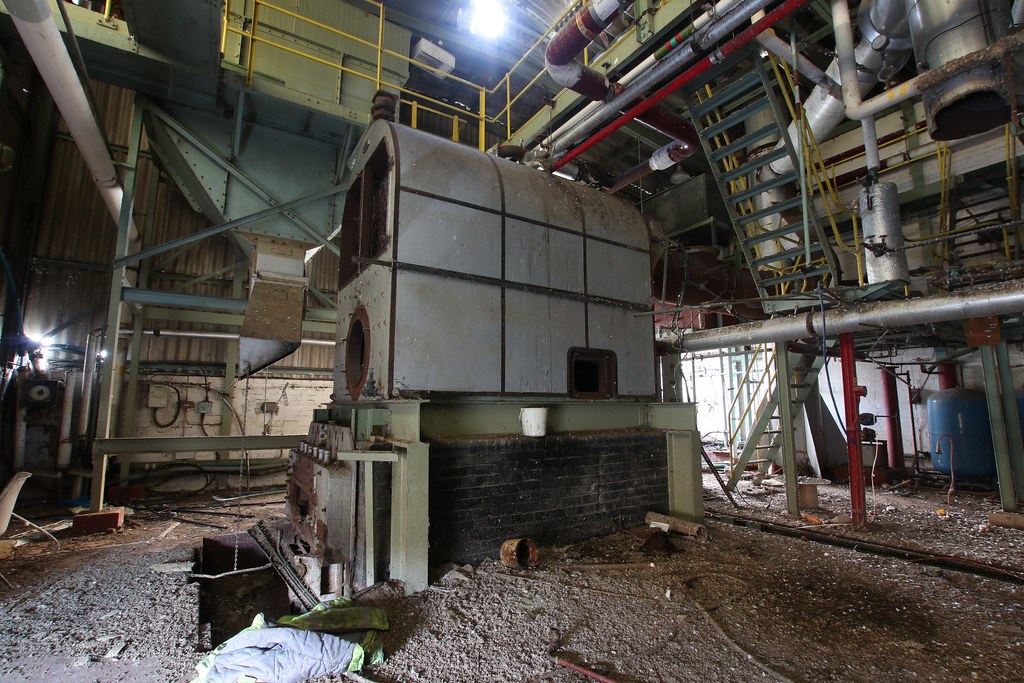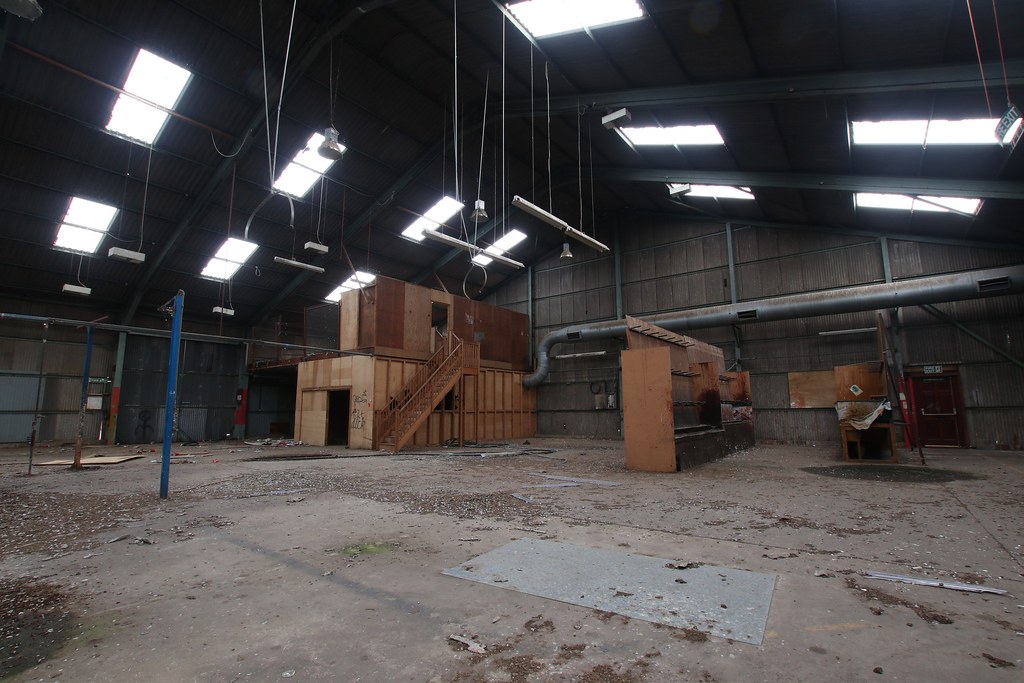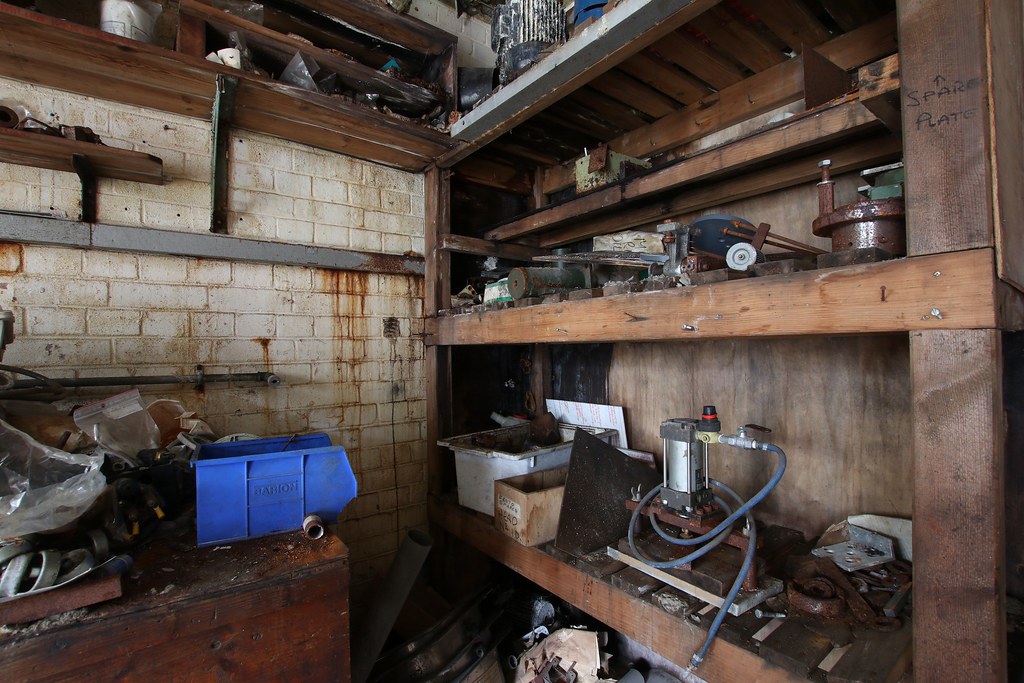For years I have wanted to see this place. It would pop back into my consciousness occasionally, I saw it from the outside on a trip to East Anglia about five or so years ago, but it was always so far away and with the security presence front and centre by the most attractive part, it was never really a viable option for me. However all that changed earlier this year, when I became aware that security had disappeared and hadn't been on site for some months, so a somewhat hastily organised weekend away was planned with Jeld Wen at the centre of the plans for the weekend.
The security disappearing coincided with the council plowing an access road through part of the site to get to their shiny new headquarters next to it, in doing so a whole line of storage sheds have been demolished weirdly leaving three isolated on their own at the far end on the other side of the road. The new 'gull wing' bridge is being constructed over the river nearby, and we believe the likelihood is when that is complete Jeld Wen will be demolished to kick start the regeneration of the area.
History shamelessly stolen from @KPUrban_
Since security vanished, the local idiots and pikeys have made a serious mess of parts of it however the good stuff is still very good. Their main focus seems to have been the main workshop building, which is in a right state now, there are also piles of sheathing and wire dotted around the extraction pipes where metal thieves have been burning the cables. However the site is so vast that the damage is still fairly minimal overall, concentrated on the easy to reach areas, but it does show how quickly something can go downhill when security go away. I did find the smashed up security building quite funny though.
We had a relaxed and uninterruped (save for the seagulls) run of the place for a few hours, I did have a look at climbing up to the higher reaches of the extraction plant but after getting to the top of the one climbable ladder, realised that the metal walkway was in a bad shape with plants growing out of it so decided I'd rather not fall to my death for the sake of some photos - 13 years exposed to salty air has really done a number on them. In all honesty it's a relief that the lower two flights of stairs up have been cut off, because the higher up flights and walkways between them are in a seriously bad way with all the metal separating and big rust holes in them.
On with the photos, first stop, of course, the massive sawdust extraction and storage plant. The enclosed pipe bridge heading to the right connects to the extraction plant in the ceiling of the main workshop.








Moving into the boiler house, with it's carpet of pigeon shit over everything and resident pigeons making a nuisance of themselves.



On into the drying plant, these fans were a good 6ft in diameter.







The rear end of the enormous main workshop building.

Outside storage sheds.

Maintenance garage.

Looking down towards the site entrance, the main workshop on the left.

Timber treatment building, not a lot left here.


Continued....
The security disappearing coincided with the council plowing an access road through part of the site to get to their shiny new headquarters next to it, in doing so a whole line of storage sheds have been demolished weirdly leaving three isolated on their own at the far end on the other side of the road. The new 'gull wing' bridge is being constructed over the river nearby, and we believe the likelihood is when that is complete Jeld Wen will be demolished to kick start the regeneration of the area.
History shamelessly stolen from @KPUrban_
Jeld Wen is an American company dating back to just before 1960 with the founder Richard Wendt. Richard "Dick" Wendt had learned to manage a manufacturing business from his father, an executive of Caradco, who sent him to Oregon to help run their millwork plant (Millwork being a building material traditionally produced at a wood mill such as doors or windows).
A few years down the line the Caradco company decided to sell the Oregon plant and Dick Wendt along with 4 of his business partners decided to purchase the factory and assets starting as their own business named Jeld-Wen. The factory's workforce was at 15 employees but within a couple years the plant was eventually able to afford new manufacturing facilities offering a wider range of material choices such as vinyl and metals like aluminium. The resourcefulness and reliably to make a quality product allowed Jeld Wen to grow rapidly in the 70's and 80's using a method known as vertical integration allowed them to purchase suppliers allowing costs to be lowered and ultimately increasing their profit to reach heights of $350 Million profit by 1989.
The 1990s saw the company expand across the globe reaching the UK. The Lowestoft plant, covering around 14 Hectares (Roughly 34 Acres) of land right next to the port, was taken over from the Rugby Joinery around 1993 and into the control of Jeld-Wen.
The Lowestoft plant continued operation way into the 2000s Until news in early December 2009 soon saw the demise of the plant. A recent drop in the construction industry meant that the company had to cut costs to save money and shortly after the news was announced the plant would close after Christmas leaving the plant disused and the 194 workforce redundant.
Since security vanished, the local idiots and pikeys have made a serious mess of parts of it however the good stuff is still very good. Their main focus seems to have been the main workshop building, which is in a right state now, there are also piles of sheathing and wire dotted around the extraction pipes where metal thieves have been burning the cables. However the site is so vast that the damage is still fairly minimal overall, concentrated on the easy to reach areas, but it does show how quickly something can go downhill when security go away. I did find the smashed up security building quite funny though.
We had a relaxed and uninterruped (save for the seagulls) run of the place for a few hours, I did have a look at climbing up to the higher reaches of the extraction plant but after getting to the top of the one climbable ladder, realised that the metal walkway was in a bad shape with plants growing out of it so decided I'd rather not fall to my death for the sake of some photos - 13 years exposed to salty air has really done a number on them. In all honesty it's a relief that the lower two flights of stairs up have been cut off, because the higher up flights and walkways between them are in a seriously bad way with all the metal separating and big rust holes in them.
On with the photos, first stop, of course, the massive sawdust extraction and storage plant. The enclosed pipe bridge heading to the right connects to the extraction plant in the ceiling of the main workshop.

Moving into the boiler house, with it's carpet of pigeon shit over everything and resident pigeons making a nuisance of themselves.

On into the drying plant, these fans were a good 6ft in diameter.

The rear end of the enormous main workshop building.
Outside storage sheds.
Maintenance garage.
Looking down towards the site entrance, the main workshop on the left.
Timber treatment building, not a lot left here.

Continued....



